Page 283 of 313
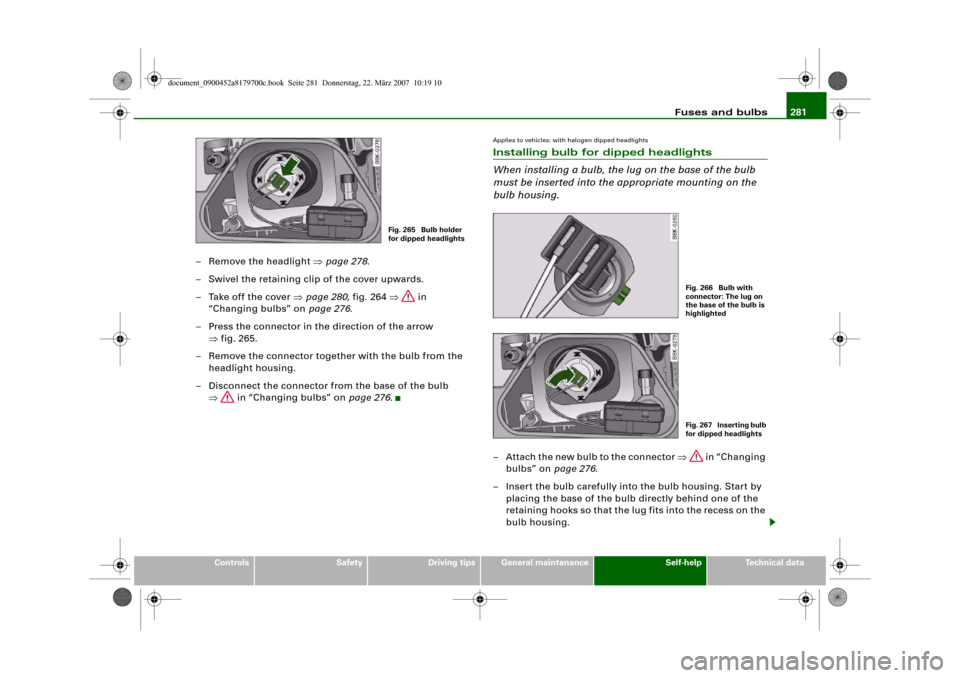
Fuses and bulbs281
Controls
Safety
Driving tips
General maintenance
Self-help
Technical data
– Remove the headlight ⇒page 278.
– Swivel the retaining clip of the cover upwards.
– Take off the cover ⇒page 280, fig. 264 ⇒ in
“Changing bulbs” on page 276.
– Press the connector in the direction of the arrow
⇒fig. 265.
– Remove the connector together with the bulb from the
headlight housing.
– Disconnect the connector from the base of the bulb
⇒ in “Changing bulbs” on page 276.
Applies to vehicles: with halogen dipped headlightsInstalling bulb for dipped headlights
When installing a bulb, the lug on the base of the bulb
must be inserted into the appropriate mounting on the
bulb housing.– Attach the new bulb to the connector ⇒ in “Changing
bulbs” on page 276.
– Insert the bulb carefully into the bulb housing. Start by
placing the base of the bulb directly behind one of the
retaining hooks so that the lug fits into the recess on the
bulb housing.
Fig. 265 Bulb holder
for dipped headlights
Fig. 266 Bulb with
connector: The lug on
the base of the bulb is
highlightedFig. 267 Inserting bulb
for dipped headlights
document_0900452a8179700c.book Seite 281 Donnerstag, 22. März 2007 10:19 10
Page 285 of 313
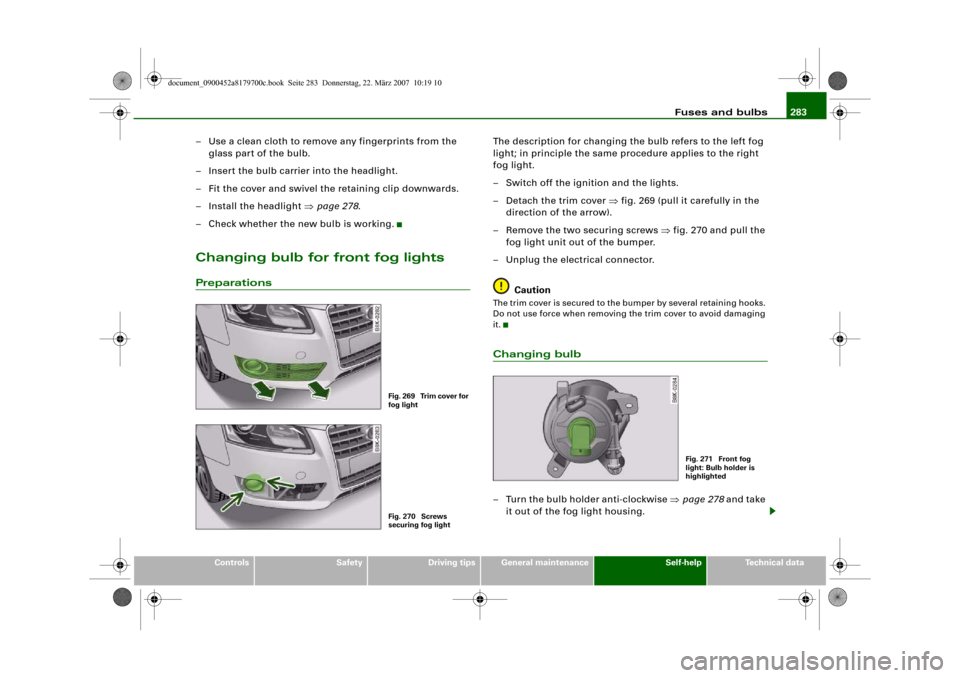
Fuses and bulbs283
Controls
Safety
Driving tips
General maintenance
Self-help
Technical data
– Use a clean cloth to remove any fingerprints from the
glass part of the bulb.
– Insert the bulb carrier into the headlight.
– Fit the cover and swivel the retaining clip downwards.
– Install the headlight ⇒page 278.
– Check whether the new bulb is working.Changing bulb for front fog lightsPreparations
The description for changing the bulb refers to the left fog
light; in principle the same procedure applies to the right
fog light.
– Switch off the ignition and the lights.
– Detach the trim cover ⇒fig. 269 (pull it carefully in the
direction of the arrow).
– Remove the two securing screws ⇒fig. 270 and pull the
fog light unit out of the bumper.
– Unplug the electrical connector.
CautionThe trim cover is secured to the bumper by several retaining hooks.
Do not use force when removing the trim cover to avoid damaging
it.Changing bulb– Turn the bulb holder anti-clockwise ⇒page 278 and take
it out of the fog light housing.
Fig. 269 Trim cover for
fog lightFig. 270 Screws
securing fog light
Fig. 271 Front fog
light: Bulb holder is
highlighted
document_0900452a8179700c.book Seite 283 Donnerstag, 22. März 2007 10:19 10
Page 287 of 313
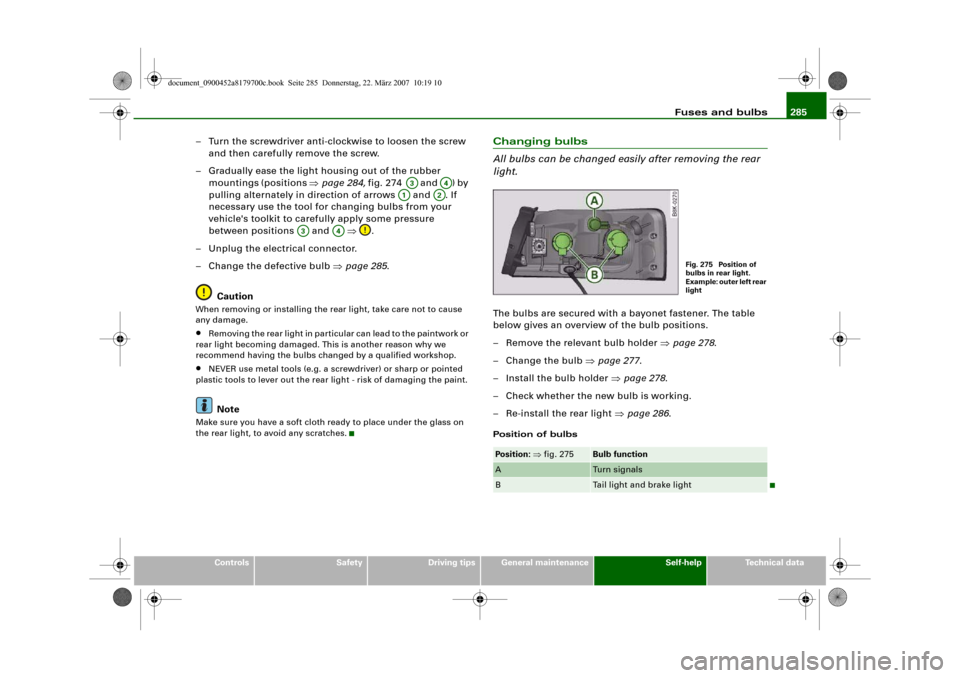
Fuses and bulbs285
Controls
Safety
Driving tips
General maintenance
Self-help
Technical data
– Turn the screwdriver anti-clockwise to loosen the screw
and then carefully remove the screw.
– Gradually ease the light housing out of the rubber
mountings (positions ⇒page 284, fig. 274 and ) by
pulling alternately in direction of arrows and . If
necessary use the tool for changing bulbs from your
vehicle's toolkit to carefully apply some pressure
between positions and ⇒.
– Unplug the electrical connector.
– Change the defective bulb ⇒page 285.
CautionWhen removing or installing the rear light, take care not to cause
any damage.•
Removing the rear light in particular can lead to the paintwork or
rear light becoming damaged. This is another reason why we
recommend having the bulbs changed by a qualified workshop.
•
NEVER use metal tools (e.g. a screwdriver) or sharp or pointed
plastic tools to lever out the rear light - risk of damaging the paint.Note
Make sure you have a soft cloth ready to place under the glass on
the rear light, to avoid any scratches.
Changing bulbs
All bulbs can be changed easily after removing the rear
light.The bulbs are secured with a bayonet fastener. The table
below gives an overview of the bulb positions.
– Remove the relevant bulb holder ⇒page 278.
–Change the bulb ⇒page 277.
– Install the bulb holder ⇒page 278.
– Check whether the new bulb is working.
– Re-install the rear light ⇒page 286.Position of bulbs
A3
A4
A1
A2
A3
A4
Position: ⇒fig. 275
Bulb function
A
Turn signals
B
Tail light and brake light
Fig. 275 Position of
bulbs in rear light.
Example: outer left rear
light
document_0900452a8179700c.book Seite 285 Donnerstag, 22. März 2007 10:19 10
Page 289 of 313
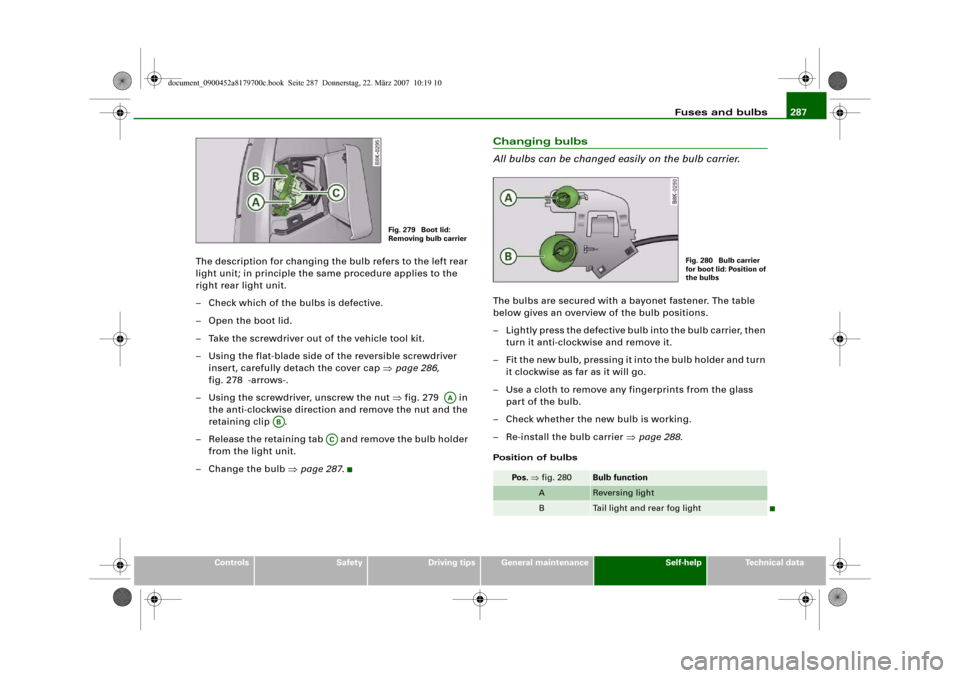
Fuses and bulbs287
Controls
Safety
Driving tips
General maintenance
Self-help
Technical data
The description for changing the bulb refers to the left rear
light unit; in principle the same procedure applies to the
right rear light unit.
– Check which of the bulbs is defective.
– Open the boot lid.
– Take the screwdriver out of the vehicle tool kit.
– Using the flat-blade side of the reversible screwdriver
insert, carefully detach the cover cap ⇒page 286,
fig. 278 -arrows-.
– Using the screwdriver, unscrew the nut ⇒fig. 279 in
the anti-clockwise direction and remove the nut and the
retaining clip .
– Release the retaining tab and remove the bulb holder
from the light unit.
– Change the bulb ⇒page 287.
Changing bulbs
All bulbs can be changed easily on the bulb carrier.The bulbs are secured with a bayonet fastener. The table
below gives an overview of the bulb positions.
– Lightly press the defective bulb into the bulb carrier, then
turn it anti-clockwise and remove it.
– Fit the new bulb, pressing it into the bulb holder and turn
it clockwise as far as it will go.
– Use a cloth to remove any fingerprints from the glass
part of the bulb.
– Check whether the new bulb is working.
– Re-install the bulb carrier ⇒page 288.Position of bulbs
Fig. 279 Boot lid:
Removing bulb carrier
AA
AB
AC
Pos. ⇒fig. 280
Bulb function
A
Reversing light
B
Tail light and rear fog light
Fig. 280 Bulb carrier
for boot lid: Position of
the bulbs
document_0900452a8179700c.book Seite 287 Donnerstag, 22. März 2007 10:19 10
Page 291 of 313
Fuses and bulbs289
Controls
Safety
Driving tips
General maintenance
Self-help
Technical data
Changing bulb
– Press the defective bulb out of the bulb holder and fit the
new bulb.
Installing number plate light
– First insert the side with the retaining element
⇒page 288, fig. 283 and then carefully press the number
plate light into the opening.
– Check whether the new bulb is working.
document_0900452a8179700c.book Seite 289 Donnerstag, 22. März 2007 10:19 10
Page 293 of 313
291 Technical data
document_0900452a8179700c.book Seite 291 Donnerstag, 22. März 2007 10:19 10
Page 294 of 313
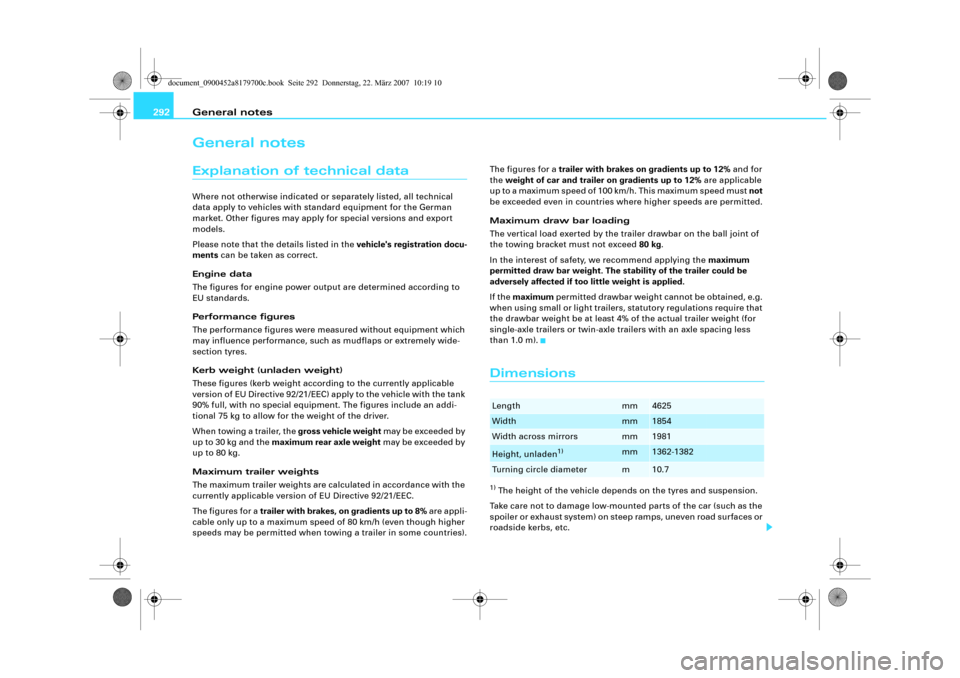
General notes 292General notesExplanation of technical dataWhere not otherwise indicated or separately listed, all technical
data apply to vehicles with standard equipment for the German
market. Other figures may apply for special versions and export
models.
Please note that the details listed in the vehicle's registration docu-
ments can be taken as correct.
Engine data
The figures for engine power output are determined according to
EU standards.
Performance figures
The performance figures were measured without equipment which
may influence performance, such as mudflaps or extremely wide-
section tyres.
Kerb weight (unladen weight)
These figures (kerb weight according to the currently applicable
version of EU Directive 92/21/EEC) apply to the vehicle with the tank
90% full, with no special equipment. The figures include an addi-
tional 75 kg to allow for the weight of the driver.
When towing a trailer, the gross vehicle weight may be exceeded by
up to 30 kg and the maximum rear axle weight may be exceeded by
up to 80 kg.
Maximum trailer weights
The maximum trailer weights are calculated in accordance with the
currently applicable version of EU Directive 92/21/EEC.
The figures for a trailer with brakes, on gradients up to 8% are appli-
cable only up to a maximum speed of 80 km/h (even though higher
speeds may be permitted when towing a trailer in some countries).The figures for a trailer with brakes on gradients up to 12% and for
the weight of car and trailer on gradients up to 12% are applicable
up to a maximum speed of 100 km/h. This maximum speed must not
be exceeded even in countries where higher speeds are permitted.
Maximum draw bar loading
The vertical load exerted by the trailer drawbar on the ball joint of
the towing bracket must not exceed 80 kg.
In the interest of safety, we recommend applying the maximum
permitted draw bar weight. The stability of the trailer could be
adversely affected if too little weight is applied.
If the maximum permitted drawbar weight cannot be obtained, e.g.
when using small or light trailers, statutory regulations require that
the drawbar weight be at least 4% of the actual trailer weight (for
single-axle trailers or twin-axle trailers with an axle spacing less
than 1.0 m).
Dimensions1) The height of the vehicle depends on the tyres and suspension.
Take care not to damage low-mounted parts of the car (such as the
spoiler or exhaust system) on steep ramps, uneven road surfaces or
roadside kerbs, etc.Length
mm
4625
Width
mm
1854
Width across mirrors
mm
1981
Height, unladen
1)
mm
1362-1382
Turning circle diameter
m
10.7
document_0900452a8179700c.book Seite 292 Donnerstag, 22. März 2007 10:19 10
Page 295 of 313
General notes293
Controls
Safety
Driving tips
General maintenance
Self-help
Technical data This applies especially when the vehicle is fully laden.
CapacitiesFuel tank
Windscreen washerVehicle identification data
Vehicle identification number on the sound
system or MMI
– Select: Function selector button > Vehicle ID
number ⇒fig. 284.Vehicle identification number in the engine
compartment
The vehicle identification number is located on the right-hand side
of the engine compartment.
Type plate
The type plate is located on the right-hand side of the engine
compartment. Vehicles for certain export countries have no type
plate.
Front-wheel drive
ltr.
approx. 64
Four-wheel drive
ltr.
approx. 65
Windscreen and
headlight washer system*
ltr.
approx. 4.5
Fig. 284 MMI display:
Vehicle identification
number
Fig. 285 Vehicle data
sticker
CAR
document_0900452a8179700c.book Seite 293 Donnerstag, 22. März 2007 10:19 10